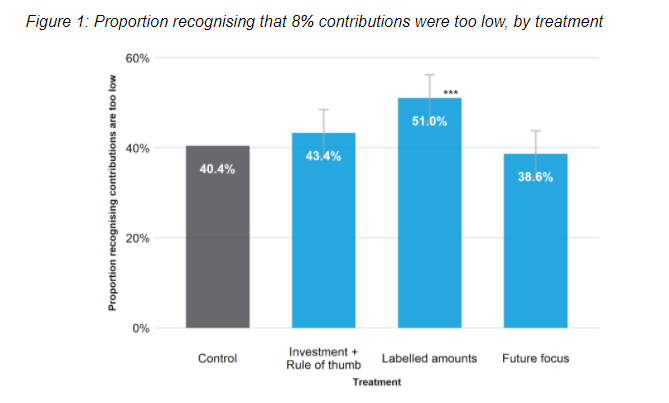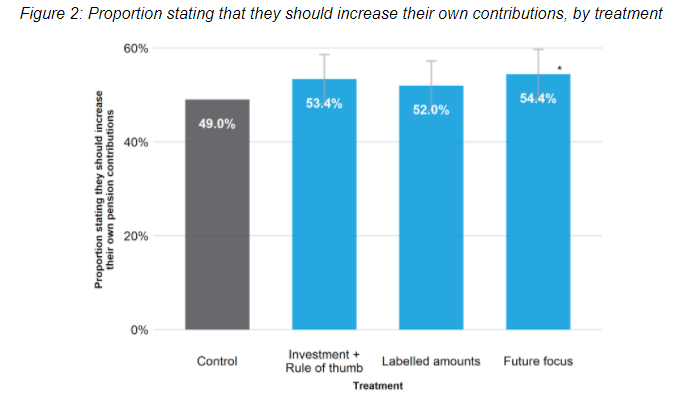Automatic pension enrolment has been one of the UK’s most successful behavioural policy interventions. Making sure workplaces have to enroll their employees into a pension plan by default, rather than relying on people to set up a pension themselves, has resulted in around 90% of eligible workers becoming enrolled in a workplace pension. Perhaps most importantly, it has been especially effective at boosting contribution rates from those who are the least financially secure.
But whilst the policy has been highly successful at increasing the number that contribute to a pension, the reality is many people still are not putting away enough for their retirement. The default contribution levels under pensions auto-enrolment are 5% employee contributions with employers contributing a further 3%. However, saving 8% of your salary is not sufficient for most people to reach a comfortable retirement. And young people are particularly at risk – 49% of 22-29 year olds are still not saving enough for a retirement above the poverty line. Fortunately, they are also the cohort with the most time to take action now to secure their future, and pension providers are working hard to understand how best to engage young people with their pensions.
With this in mind, BIT partnered with Scottish Widows to conduct an online experiment with 2,800 young people in the UK on BIT’s Predictiv platform. The experiment aimed to measure how they would view pension contributions depending on different types of communication frames, as well as map out young peoples’ understanding of and attitudes towards their pension. We wanted to know:
- How young people in the UK think about retirement,
- How much they feel they should be contributing to their pension, and
- What types of messages would be most likely to shift young people’s behaviour when it comes to planning for later life.
What we learned about the problem
In line with findings about young people not doing enough for retirement, over a third of young people (37.3%) either didn’t have a pension or didn’t know if they had one. Unsurprisingly, the proportion without a pension grows smaller as age increases. However, even at age 29, around a quarter (27%) reported either not having a workplace pension or not knowing. This is concerning, as it means that a substantial portion of young people have already missed out on the benefits of early savings, and may speak to the increasing rates of freelance/non-traditional employment among young people.
We also found that young people were relatively pessimistic about their retirements – nearly 90% stated that they were either not at all confident, a little confident, or moderately confident that they were doing enough for their retirement. And they generally expect to retire later than they actually want to retire – in fact over 1 in 5 (21.9%) expect to either retire after 70, or never actually stop working.
What we can do about it
We wanted to know what we could do to increase engagement. So, we asked young people to read a short vignette about a hypothetical friend of theirs, 25 year old (‘Alex’), who had a representative income and default pension contributions. They were then randomised to see one of four communications, presented as information aimed at Alex that came from Alex’s pension provider. This information conveyed the importance of pensions, and encouraged ‘Alex’ to take action to contribute more to their pension.
The different arms in the trial were:
- A control that used existing wording commonly used by Scottish Widows in its existing marketing, and warned that the minimum amounts may not be enough for a comfortable retirement. It also focused on pensions as a savings vehicle.
- Investments/ rules of thumb where pensions were framed as an investment, rather than savings. It also included rules of thumb about the power of saving early – e.g., ‘a pound saved at age 25 could be worth 4 times as much as a pound saved at age 55’. Finally, it included the financial impacts of increasing contributions to 12% or 15%.
- Labelled amounts which explained that 12% is needed to stay above the poverty line, and most will need 15% for a comfortable retirement. The calls to contribute 12% and 15% were labelled the ‘minimum’ and ‘comfortable’ amounts, respectively.
- Future focus which was slightly different – prior to starting the survey, people were asked to pause and reflect about their retirement, and life after work. The communication itself also asked the reader to pause and think about the future, and noted an extra £80 a month now may mean they have up to £150 a month more in retirement.
There were a number of interesting results. Firstly, we found that the Labelled amounts arm was the most effective at making it clear that the default contribution amount was too low, by a substantial margin – respondents were 26.2% more likely to agree that Alex’s default contributions were too low, this arm also more than doubled the proportion that recommended Alex increase contributions to 15%. This results suggests that many people struggle to connect present decisions to retirement outcomes in a concrete way, and clearly labelling current options makes the impact that contribution decisions today can have on retirement outcomes in the future more salient.

In contrast, the Future focus arm led to the greatest increase in people believing that they should increase their own contributions. This is a fascinating insight – whilst the Labelled amounts arm increases people’s perceptions of what other people should do, when it comes to our own behaviour and intentions we have different motivations. This is in line with a key finding from behavioural science, namely that we don’t relate to our future selves and it is difficult for us to make decisions that will pay off in the long-term. This result supports wider academic work that shows that encouraging people to pause and reflect on their future encourages them to make decisions that are more beneficial for their future selves.

Where to next
These results and many more can be found in our report, but they are really the first step. From here, there are a range of actions that regulators, employers and pensions providers can do:
- Given the growth in freelancing among young people and the substantial proportion without a workplace pension, regulators could consider using tax return data to identify those young people who are self-employed and don’t currently have a pension, and reach out to them using some of the insights from our trial.
- Employers could make sure that when new employees are automatically enrolled, they are prompted with information that labels contribution amounts and ties them to long-term retirement outcomes.
- Pension providers could try to identify when workers change jobs or receive a pay increase (based on changes in contributions or details), and use those as opportunities to prompt workers to think about their future and increase contributions.
- And all parties could take the results from our trial and look to replicate the findings in the field, to see what sorts of communications actually work to drive increased engagement and higher contributions.





